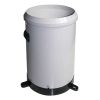KISTERS TB7 Tipping Bucket Rain Gauge
Features
- Integrated bird guard
- Minimal maintenance required
- Robust design for all environments
- Free ground shipping
- Expedited repair and warranty service
- Lifetime technical support
- More
Overview
The KISTERS TB7 is a new generation high-quality tipping bucket rain gauge for measuring rainfall and precipitation in remote and unattended locations. TB7 is a reliable ‘low-cost’ device with very good accuracy across a broad range of rainfall intensities.
Design
The TB7’s tried and proven design ensures long-term, accurate and repeatable results. It is manufactured from high-quality, durable materials, ensuring long-term stability in the harshest of environments. The enclosure and base consist of robust UV-resistant ASA polymer, and fasteners and filter are made of stainless steel.
Mechanics
TB7 provides a finger filter that ensures the collector catch area remains unblocked when leaves, bird droppings and other debris find their way into the catch. The TB7’s base incorporates two water outlets at the bottom allowing for water collection and data verification.
Resolution 0.2 mm, 0.5 mm, 0.01”
Range 700 mm per hour
Accuracy Resolution
0.2 mm 0.01“ 0.5 mm
Flow rate 0-200 mm/hr +/-5 % +/-5 % +/-5 %
Flow rate 200-500 mm/hr NA NA better than -8 %
Alternatively: Individual accuracy +/-2 % at any set intensity
specified by the user, calibration required.
(Please note: additional costs for individually calibrated units)
Enclosure and Base UV-resistant ASA
Pivots Ground sapphire pivots
Bucket Teflon impregnated injection moulded
Dimensions Height: 310 mm (H)
Catch: 200 mm diameter
Mass 2.1 kg
In The News
Monitoring Mariculture in the Gulf of Alaska
The mariculture industry in the Gulf of Alaska has been steadily growing in recent years, guided by ongoing research to help refine farm location and cultivation practices. A subset of aquaculture, mariculture focuses on rearing organisms in the open ocean. In Alaska, finfish farming is illegal, so most farms cultivate kelp, oysters, or a combination of the two. These small, locally operated farms started popping up in the Gulf of Alaska in the early 1990s, when shellfish farming first became legal. Kelp farming did not begin to catch on in the state until 2016. Many of the coastal areas that have grown interested in mariculture are historically commercial fishing communities.
Read MoreSupplying Seattle’s Drinking Water: Using Data Buoys to Monitor the Cedar River Municipal Watershed
Providing clean, safe, and reliable drinking water for the 1.6 million people in the greater Seattle area is a top priority for Seattle Public Utilities (SPU). With limited water supplies, SPU dedicates considerable resources to maintain its watersheds and mountain reservoirs. About 70 percent of Seattle Water comes from the Cedar River Municipal Watershed , and the other 30 percent comes from the South Fork Tolt River Watershed . [caption id="attachment_39574" align="alignnone" width="940"] Data buoy in Chester Morse Lake . (Credit: Kevin Johnson / Seattle Public Utilities) [/caption] Jamie Thompson, a fisheries biologist at SPU, monitors aquatic ecosystems centered on fish listed under the U.S. Endangered Species Act (ESA).
Read MoreData-Driven Advocacy on the Lower Deschutes River
Like many freshwater environments, the Deschutes River in Oregon is under pressure from development, pollution, and climate change. Many rivers, streams and lakes in the Deschutes Basin do not meet Oregon water quality standards –where state water quality monitoring assesses levels of bacteria, pH, dissolved oxygen, temperature, and fine sediment. Hannah Camel is the Water Quality Coordinator for the Deschutes River Alliance (DRA), a non-profit organization that focuses on the health of the lower 100 miles of the Deschutes River–the area most affected by human intervention. As a data-driven organization, the DRA has benefited from the installation of two NexSens X2 data loggers.
Read More















